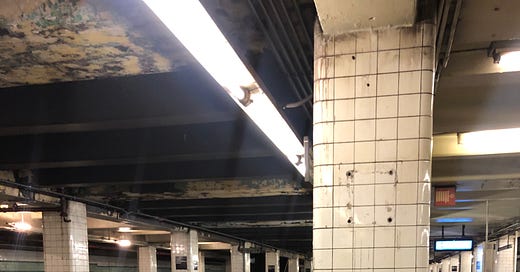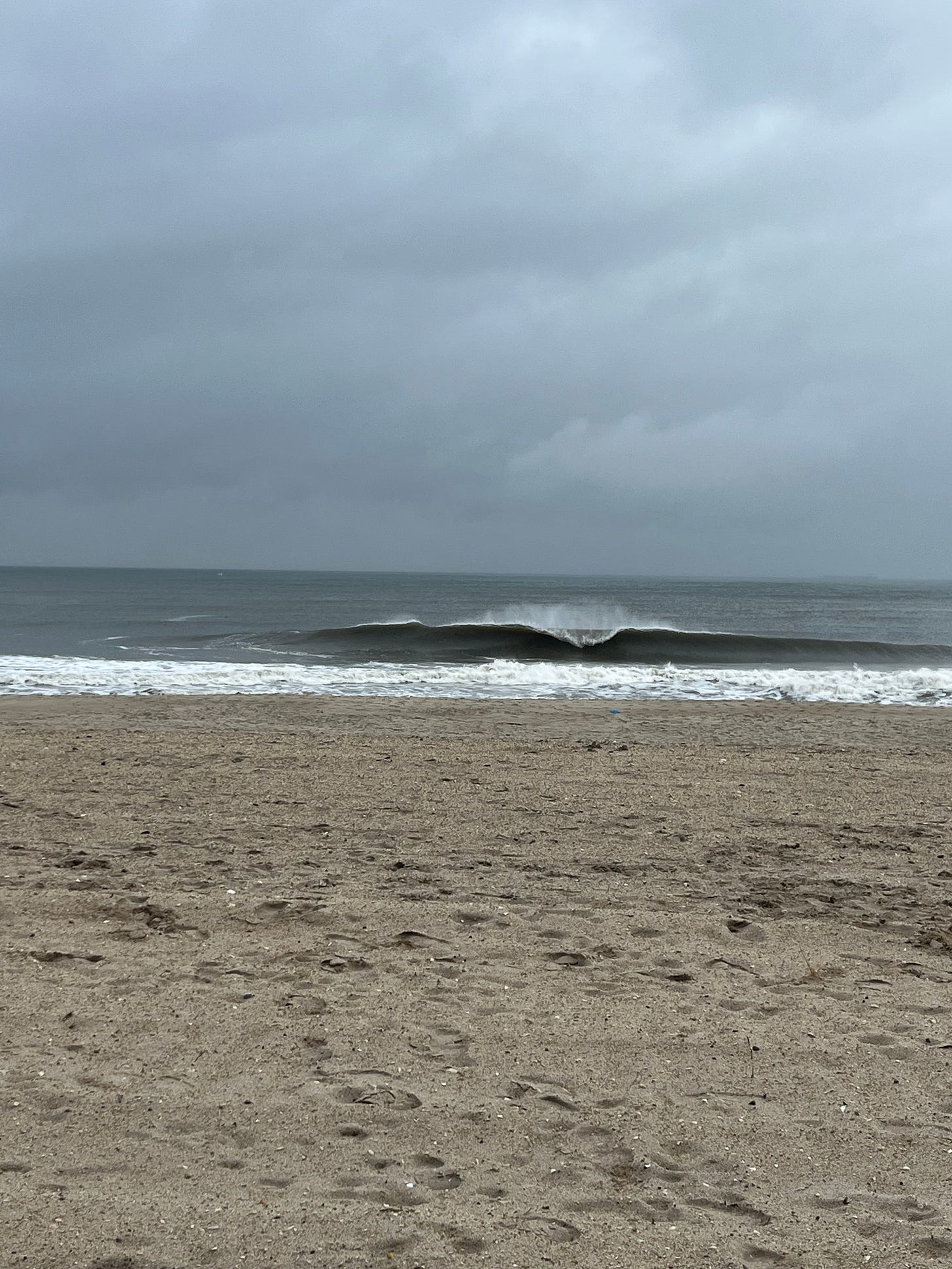Surfing in California is easy. You drive your car to the beach, it’s never that cold (with the exception of Ocean Beach in San Francisco), the waves are generally rideable most days. But it’s also crowded and the culture can be insular and unfriendly.
Surfing in New York is different— nothing about it is easy, and the infrastructure that enables it is almost entirely accidental. The swell outlook changes frequently. There are weeks with no swell at all. You cross your fingers that the good day is the day when you don’t have much to do. But when it’s good, you can literally ride the train straight to perfect waves. Having grown up in the car culture of California, this last point excites me endlessly.
I bought a new board when my wife and I moved to New York. 4’6” and styrofoam, surprisingly buoyant for its size. Small and durable enough to tote around the subway easily. I used to ride real boards— urethane and fiberglass, fast and responsive. But I had a car then, and now I ride the subway, so my styrofoam board is better.
Surfing in New York is not for the faint of heart. It’s cold in the winter. The waves are fast and hollow, the currents are strong. I enjoy the experience, but it scares me sometimes. I like it because it still feels like a secret— one not kept by any express intention, but instead by limited appeal. Only a relative handful of people even consider surfing when there’s snow on the ground.
It also feels quietly subversive— I’ve never lived anywhere more addicted to the grind than New York. Time is money here, and under this premise, my hobby/addiction is a colossal waste. But in the end, I relish it even more for that reason— It’s a practice in unplugging from the intensity, a place to just exist, to take waves as they come to me and to be alone with my thoughts.
The surfing begins as soon as you leave the house, balancing your board under your arm on your bike, riding to the closest A train. You attract attention, because who would do that on a Wednesday afternoon in March?
Once you’re underground it’s one long, slow tube ride. The roar of the machinery is all consuming. You can’t do much. The ride is meditative at best, tense at worst. You read a book, you listen to music.
Like the ocean, sometimes the A train spars with you. It goes local, and your ride goes from forty minutes to two hours. You finally get to 67th street and walk through the empty neighborhood towards the beach. It’s hard to imagine that this is so close to the crowded, concrete metropolis from which you came. Weighing this, the train ride feels short. A local guy is changing out of his wetsuit and you ask how it is out there.
“Pumping, but you’d better get out there soon, the wind is starting to shift.”
You change into your 5 millimeter neoprenes as fast as you can and run across the boardwalk. You see a perfect, empty beach-break.
You wrestle with the ocean. You get caught in the impact zone when a big wave is barreling through from the outside. You have to fight just to get out to it, only to get pummeled by its heavy, fat lip. The fight takes over your entire body, your focus is fixed. You feel like you’re drowning, but you know you won’t.
You scratch your way out to the lineup. A flock of birds fly across a wave that you paddle over, so close to your head that you can see the patterns on their coat of feathers. You think: I’m alive in the big bad city.
You catch your breath and rest your body, floating, peaceful but alert, in the water in the space between the sets. More waves come, you duck the first and you take the second. You fly down the face, leaning in close to the wave. You drag your arm to slow yourself, searching for the pocket. You crouch low and feel the lip of the tube curl over your head, the cylindrical vision working like a high-speed hypnotist. This is the point of disconnection you’ve been searching for, and for a moment you feel like you’re flying, or floating, somewhere in between. It’s the most free you’ve ever felt, the longest 7 seconds of your life. You paddle out and repeat the process three, four, five times. How much time has gone by now? You can’t say.
Like the ocean, the New York City subway is loud, chaotic, even dangerous at times.
In the same two week span that a subway driver was slashed, an altercation on the Hoyt-Schermerhorn platform led to a shooting, and the governor called in the National Guard to try and curb subway violence, I witnessed a knife fight in a train car that was stopped across the platform from me.
I was on the inbound side at 67th street in Rockaway Beach, waiting for a train back into the city after a bristling surf in March when it happened. The outbound train pulled in across the tracks and I heard the screaming, saw the passengers who were splayed outward from the nucleus of the fight before I saw what was going on. In the window of the train directly across from me I saw two huge men, locked wrist to wrist, in an apparent wrestle to the death. A box cutter in the immobilized right hand of the one, a hammer in the struggling grip of the other. The fight went on in a sort of tense stalemate for several moments, punctuated by brief tremors where one managed to shift the spatial dynamics of the fight, twisting the other around. My focus was fixed intensely, and time stood still once again— this was a point of disconnection that I wasn’t looking for. My train arrived before I saw how it ended. I sat, haunted by the image, for the hour or so it took me to get back to where I parked my bike.
For weeks afterward, I scoured the internet for reports of the fight. I couldn’t find anything. Maybe some brave person was able to break it up before it became newsworthy, but nobody had volunteered yet when I left the station.
Something I love about New York is that you can still encounter mysteries, events of which you can’t find an accompanying facsimile on the internet. Things happen in real life here, like this fight, that you can’t explain and that don’t leave a digital footprint. In the highly surveilled and intensely monitored landscape that is the modern city, it feels like a miracle—albeit a disturbing one—that events so powerful can only be experienced in real time.
Surfing is the same. You get the wave, you take a picture of it in your head, you bring the memory back with you. There isn’t a medium that can accurately re-present that moment to you, you simply have to experience it as it comes in real time and then live with the fact that it’s over when it’s over. It’s a practice in submitting to forces that are outside of your control, and in doing so, learning how to ride them.
In a world where most of our activities are monitored and then put into an algorithm that then dictates the digital landscape we interact with, the ocean and the subway are stubborn sites of surprise. Sometimes the subway goes local. Sometimes there’s a knife fight. The wind changes and the waves get bigger. But that’s the charm of New York. The ocean is unruly, and so is the city.






This is awesome
love this ...don't want to take the subway anytime soon...living vicariously through you is perfect